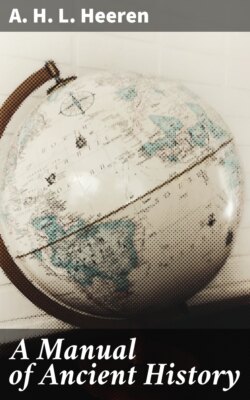Читать книгу A Manual of Ancient History - A. H. L. Heeren - Страница 18
На сайте Литреса книга снята с продажи.
ОглавлениеAcquaintance of the ancients with Africa.
1. Although the Phœnicians had circumnavigated Africa, the northern part only of that quarter of the globe was known to antiquity. With that part, however, the ancients were better acquainted than we are at the present day, the coast being then occupied by civilized and commercial nations, who pushed their excursions far inland. This was the case in early times with the Carthaginians and the Egyptians; still more so with the Macedonian Greeks, under the Ptolemies, and under the Romans. War, hunting, and commerce, were, generally speaking, the objects which gave rise to those excursions.
General view of Africa.
2. Considered as a whole, Africa is very different from Asia, both in situation and form. Asia lies almost entirely within the temperate, while Africa is almost wholly under the torrid zone. Asia abounds in deep gulfs and large rivers; Africa constitutes a regular triangle, and in its northern half possesses but two large rivers, the Nile and the Niger. No wonder, then, that this portion of our globe should form, as it were, a world in itself, distinguished by its productions and its inhabitants.
Physical geography of North Africa.
3. Physically considered, Northern Africa may be divided into three regions, distinguished in early antiquity by separate names. The maritime country along the Mediterranean, with the exception of Tripolis, or the Regio-Syrtica, consists principally of very fertile districts, and was consequently, at all times, very thickly inhabited: hence in Herodotus it bears the name of the inhabited Africa; it is now called Barbary. Above this, and under the 30th parallel of N. lat., succeeds a mountainous tract, across which stretches the Atlas chain of mountains; abounding in wild beasts and dates: hence Herodotus calls it the wild beast Africa: among the Arabs it is called the land of dates, (Biledulgerid.) Beyond this, and between the 30th and 20th degrees of N. lat. the sandy region extends right across Africa and Arabia: this part of Africa is therefore known, both among the ancients and moderns, under the name of Africa Deserta, or the Sandy Desert, (Sahara). The fruitful lands beyond the desert, stretching along the banks of the Niger, were almost wholly unknown to the Greeks: by them these parts were comprehended under the common name of Ethiopia, although that name applied more peculiarly to the districts above Egypt. The Greeks were, however, acquainted with some of the fruitful spots in the desert, the Oases; such as Augila, Ammonium, and the Oases, properly so called, in Egypt.
Political state.
4. There exists no political division which comprises the whole of Africa. The north coast alone was inhabited by civilized nations: Egyptians, Cyrenæans, and Carthaginians; of which the first only were aboriginals. The rest of the inhabitants either roved about as nomad hordes, or formed insignificant states, of whose existence we have heard some account, though we possess no history of them. Along the shore, reckoning from the Plinthinetic gulf, Egypt is succeeded by: 1st. Marmarica, a tract without cities, consisting principally of sandy deserts, occupied by nomad hordes: this country extends from the 40—47° E. long. from Ferro. 2nd. The fertile territory occupied by the Greek colonies, called Cyrenaïca, extended to the Greater Syrtis, 37—40° E. long. Cities: Cyrene, Barca. 3rd. The territory of Carthage, extending from the Greater Syrtis to the Fair Promontory, 25—40° E. long. This territory comprised (a) the country between the Greater and Lesser Syrtis, (Regio Syrtica,) which constitutes the modern kingdom of Tripoli; a sandy tract, almost wholly occupied by nomads. (b) the territory of Carthage, properly so called, (kingdom of Tunis). A very fruitful country; the southern part, called Byzacena, the northern part Zeugitana. Cities: Carthage, Utica, etc. 4th. Numidia and Mauritania; occupied during the Carthaginian age by nomad races. Along the shore some Carthaginian settlements.
